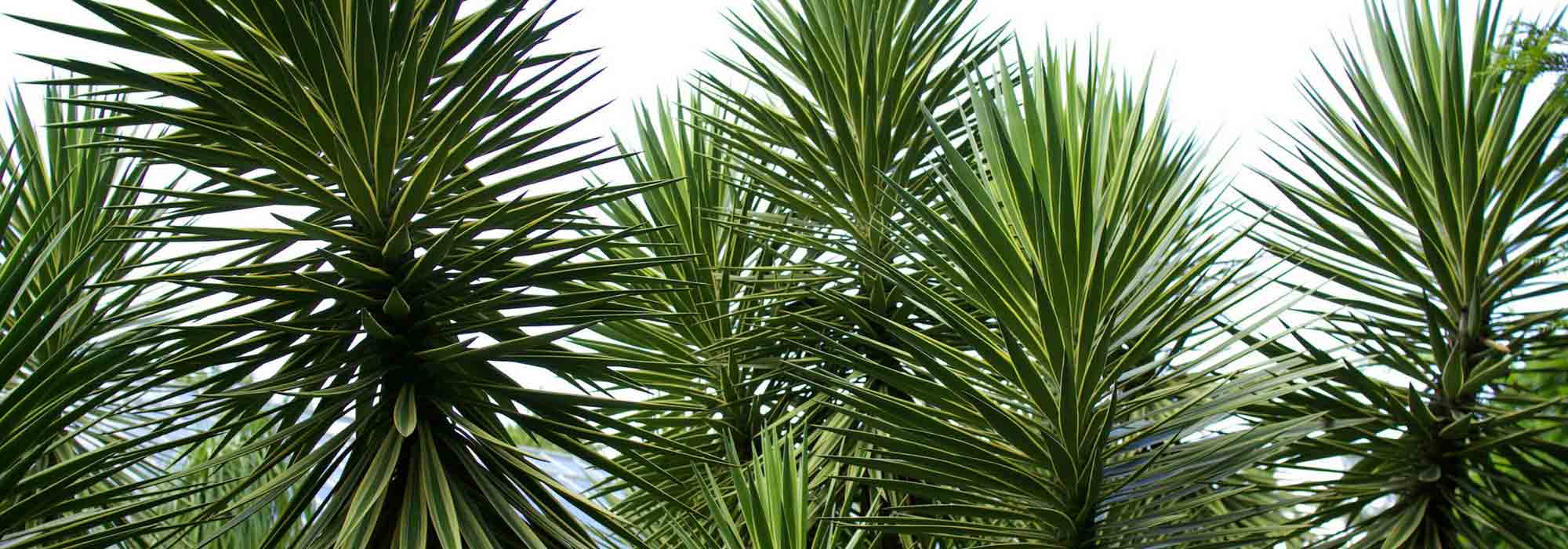
Outdoor yucca: choice, planting, care, in pot or in the garden
Contents
Yucca in a nutshell
- Yucca is indeed a hardy young plant for outdoor use, capable of withstanding cold in the garden
- Its sword-shaped leaves and graphic silhouette provide a very exotic atmosphere to the garden throughout the year
- Its summer flowering with white bell-shaped flowers is spectacular
- Exemplarily undemanding, once well established in full sun and well-drained soil, it requires no maintenance
- An architectural plant, Yucca structures large flower beds and exotic rockeries
A word from our expert
Contrary to popular belief, the Yucca is not just an indoor plant! It is also a lush hardy perennial that is cold-resistant (-20°C), providing a very exotic atmosphere to the garden all year round. It is always noticeable from afar in the garden, especially in winter!
Both vigorous and very easy to grow, the Yucca is among the most appreciated indoor and outdoor plants. With its hairy warrior-like silhouette and spectacular summer flowering, the Yucca is undoubtedly the centrepiece of large exotic rockeries, dry slopes, or minimalist, mineral, or contemporary designs that have been very trendy in recent years.
The sword-shaped leaves, standing tall towards the sky of large outdoor yuccas like Yucca gloriosa or Yucca filamentosa, structure the space bringing breadth and verticality to all decors, from the most lush to the most sober. Less architectural, the “elephant foot yucca” (Yucca elephantipes) is a must-have indoor yucca, well-suited for pot cultivation.
Very hardy or more sensitive depending on the species, it withstands our average, slightly humid winters quite well and thrives in dry garden conditions, in any well-drained soil, even poor and stony.
To add a touch of exoticism to your garden or terrace, choose your yucca from our selection of essential or exclusive species, grown outdoors or indoors, in the ground or in pots depending on your region.
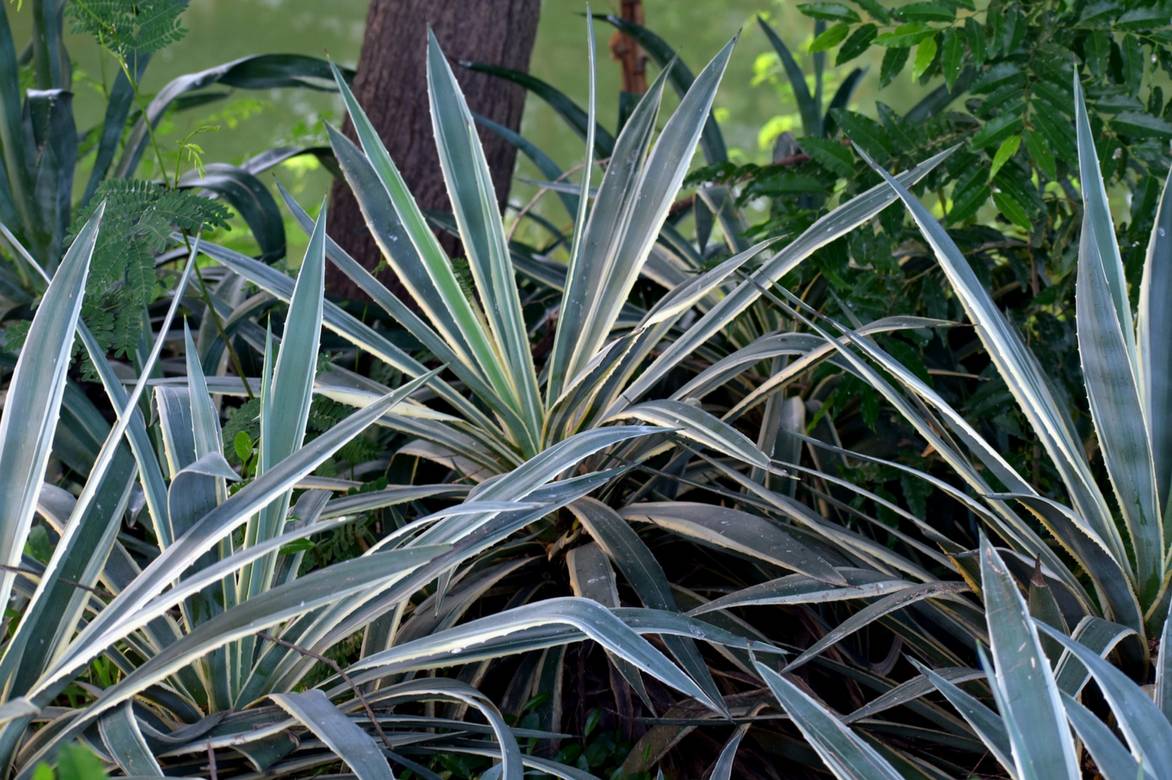
Superb foliage of a Yucca ‘Ivory Tower’
Description and botany
Botanical data
- Latin name Yucca
- Family Agavaceae
- Common name Yucca, Needle palm, Spanish dagger
- Flowering from May to October
- Height 0.60 to 5 m
- Exposure Sun
- Soil type sandy, calcareous, stony
- Hardiness -5°C to -25°C depending on the species
Belonging to the Agavaceae family, the genus Yucca comprises around forty species of perennials, bushes, and small evergreen trees native to the warm, arid, often desert regions of North and Central America, particularly Mexico.
Despite its origins, this desert dweller acclimatises very well to the climates of Western Europe. Some hardy species can withstand very low temperatures (-18°C to -25°C in dry, well-drained soil) as well as snow and even salt spray, making Yucca a plant well-suited to our temperate regions. It will thrive effortlessly along the Mediterranean or Atlantic coast.
Among the most commonly planted species in our gardens, we find Yucca gloriosa or Garden Yucca, a fully hardy species that has naturalised in many countries including France, Yucca filamentosa the hardiest and most widespread, and Yucca rigida, sometimes called Blue Yucca due to the electric blue colour of its foliage. The Yucca flaccida is a stemless species (without a trunk) that is also frequently found. The Yucca elephantipes or “Elephant foot Yucca” thrives in mild climates or is most often grown as an indoor plant.
Nearly 150 cultivars and horticultural hybrids complement this vast family.
In its natural habitat, this relative of agaves can reach over 15 metres in height. In our gardens, its size is smaller.
Despite a relatively slow growth rate, especially in the first few years, the Yucca, anchored on a powerful rootstock, can reach 3 to 4 m in all directions under our climates, growing 15 to 30 cm per year.
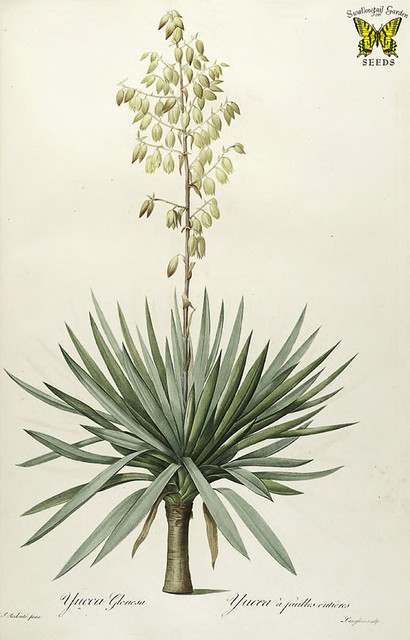
Yucca gloriosa – botanical illustration
Depending on the species, Yucca develops into a large upright tuft at the centre, naturally little branched or as a small erect tree with one or more trunks. It has a ball-shaped habit bristling with a thousand leaves in the early years, eventually forming a small tree that branches slightly into several branches, while the lower leaves dry out. After a few years, it consists of one to three trunks sometimes measuring over 10 cm in thickness.
In contrast, trunkless, the Yucca flaccida is a stemless species that develops into several leafy rosettes.
The tough leaves, upright towards the sky, are gathered in dense rosettes that are more or less arched. The evergreen foliage expresses all the charm of the antipodal cells.
From this basal rosette arises a multitude of large linear leaves, rigid in the shape of a sword very elongated and ending in a more or less sharp, brown and formidable point, inevitably reminiscent of blades slicing through the air, hence its nickname of “Spanish bayonet” or “Spanish dagger”.
Ranging in length from 20 cm to 1 m depending on the species, and up to 10 cm wide, they are sometimes slightly arched or gracefully curved at the tip.
Dark green, metallic grey-blue or yellow, the leaves are variegated or strongly marginate with yellow-cream, white-cream or blue-green in some yuccas such as Yucca ‘Bright Star’ or ‘Golden Sword’. The Yucca flaccida is distinguished by its long soft leaves that fold in two over time, fringed with characteristic curly or stiff white filaments of the species.
Before falling, the foliage forms a ‘skirt’ of dry leaves around the trunks.
Its spectacular flowering occurs only after 4 to 5 years of cultivation, or even longer depending on the climate and rarely goes unnoticed.
In early summer, sometimes later or earlier depending on the climate and lasting until autumn, from the centre of each rosette, a magnificent flower spike appears on a green and sturdy stem, towering over the tuft of foliage sometimes reaching up to 2.50 m in height.
The inflorescences gathered in branched panicles are erect, ranging from 0.20 to 1.50 m long. On this narrow and compact spike, the flowers, measuring 2 to 8 cm long, are large pendulous bells, with a waxy texture, sometimes very fragrant, ivory white, white-cream or white-blue sometimes washed with purple. Depending on the species and varieties, the flower buds take on shades of pink that contrast beautifully with the fully opened flowers resembling small tulips oriented downwards. The Yucca rostrata or Rostrated Yucca owes its name to its monumental inflorescence, reminiscent of a giant beak.
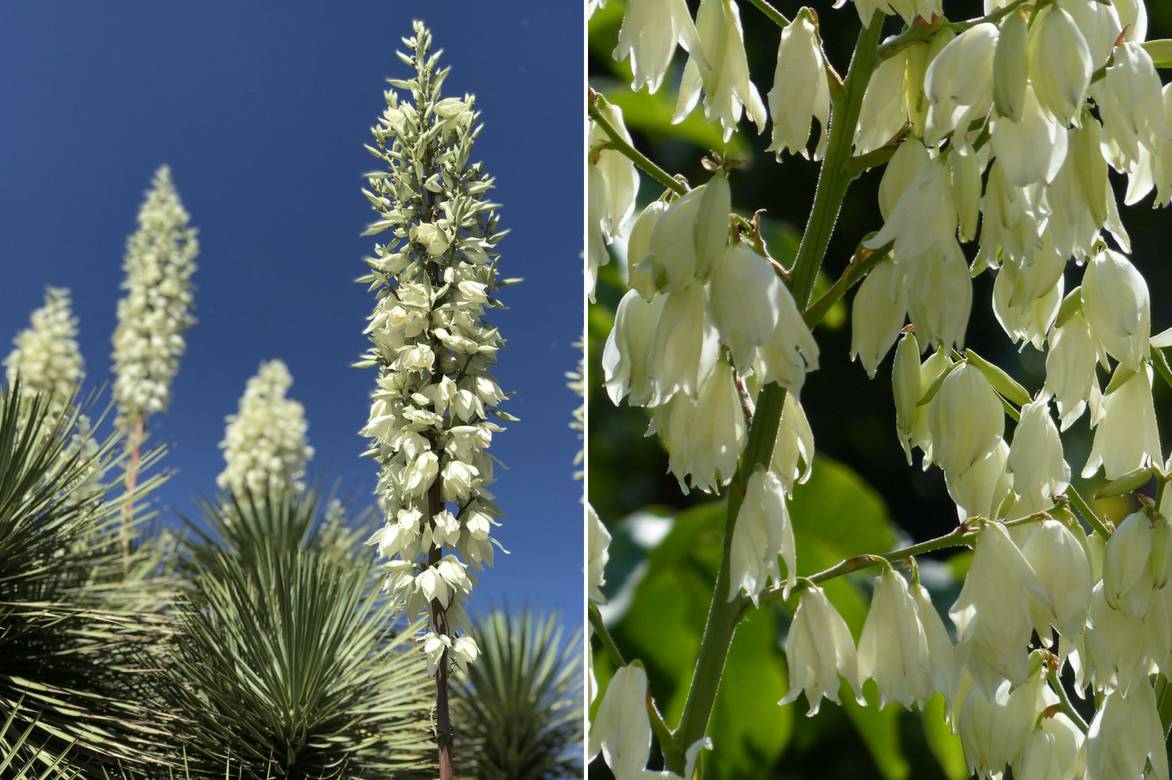
Inflorescence of a Yucca.
The Yucca will flower every year, or every two or three years depending on sunlight and climatic conditions.
Nectariferous, they attract many pollinators. In our gardens, Yucca flowers are not pollinated due to the absence of the micro pollinator butterfly, which is only present in their native habitat. Therefore, Yuccas (except for Yucca aloifolia) never produce fruits, and thus seeds!
In Yucca, flowering leads to the death of the rosette that gave birth to it, but generates the birth of numerous small offsets, ensuring the plant’s longevity.
Contrary to popular belief, beneath this beautiful exotic appearance, Yucca is much hardier and more resilient than one might think and can easily be planted outdoors in our temperate regions. Yucca, sometimes hardy well below -20°C, is easy to care for, tolerating salt spray as well as drought and high temperatures. Most species can be planted throughout France.
In open ground, the more tender varieties should be reserved for Mediterranean or Atlantic climates. In very cold and damp regions, growing in a very large pot to be brought indoors in winter is more advisable.
It thrives in sunny or even arid situations, in any ordinary soil that is well-drained, even dry, poor, sandy and stony.
Whether planted alone or in groups, with its beautiful graphic stature, Yucca structures large rockeries or beds scorched by the sun and adds a very exotic charm to a modern garden with clean lines as well as to Mediterranean-inspired gardens. It is essential in a scree garden or dry garden.

Several foliages: Yucca ‘Bright Star’, Yucca rostrata, Yucca ‘Ivory Tower’, Yucca filifera, Yucca flaccida ‘Golden Sword’.
In regions with harsh winters, it adds a contemporary touch to terraces and balconies.
The Yucca is considered a pollutant-absorbing plant that absorbs benzene and ammonia, present in cigarette smoke, paints, or cleaning products, as well as carbon monoxide released by poorly adjusted heating. Quite useful in a home!
Read also
Agave: planting, growing, and caring forMain species and varieties
From the shaggy tuft to the bush with a single or multiple trunks, there are about fifty species and more than 150 cultivars and hybrids of yuccas, all recognisable by their sword-shaped leaves pointing towards the sky.
The most common in our gardens are also the hardiest (-20 to -25 °C), such as Yucca gloriosa and Yucca filamentosa, which is trunkless. We also sometimes encounter Yucca rostrata or rostrate yucca with an inflorescence resembling a giant beak, Yucca rigida or “Blue Yucca” due to the unique colour of its foliage, and Yucca flaccida with long, soft leaves folded in two. Most also adapt very well to pot cultivation.
Whether they are large or miniature, yuccas always make a spectacular impact in a rockery in the garden or a large, well-lit room.
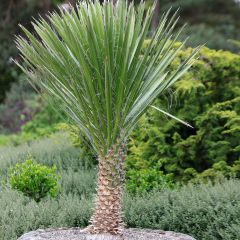
Yucca filamentosa
- Flowering time August, September
- Height at maturity 1,50 m
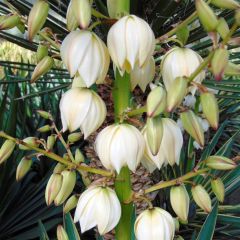
Yucca gloriosa - Spanish Dagger
- Flowering time June to August
- Height at maturity 1,50 m
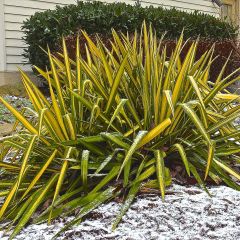
Yucca flaccida Golden Sword
- Flowering time July to September
- Height at maturity 1,50 m
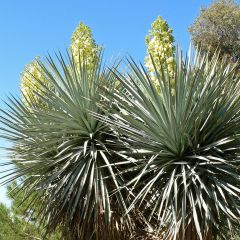
Yucca rigida
- Flowering time June to August
- Height at maturity 3 m
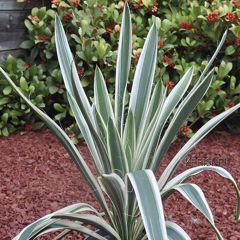
Yucca filamentosa Ivory Tower
- Flowering time July to September
- Height at maturity 70 cm
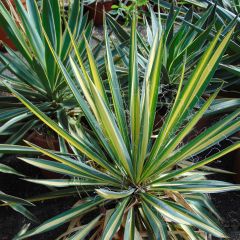
Yucca Bright Star - Variegated Yucca
- Flowering time July to September
- Height at maturity 60 cm
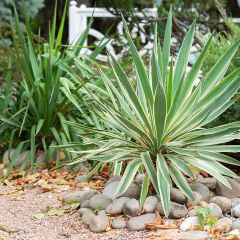
Yucca gloriosa Variegata - Spanish Dagger
- Flowering time June to August
- Height at maturity 1,50 m

Yucca filamentosa Color Guard
- Flowering time July to September
- Height at maturity 1,50 m
Discover other Yucca
View all →Available in 1 sizes
Available in 3 sizes
Available in 1 sizes
Available in 2 sizes
Available in 1 sizes
Available in 2 sizes
Available in 1 sizes
Available in 1 sizes
Available in 1 sizes
Available in 1 sizes
Planting Yucca, in pots or in the garden
Where to Plant Yucca gloriosa, Yucca filamentosa…
Native to desert regions, the Yucca surprisingly enjoys good hardiness in our latitudes, able to withstand very low temperatures down to -25°C for the hardiest varieties (yucca gloriosa, filamentosa). However, it is still advisable to choose areas that are not too humid and where frosts are short-lived for planting it in the ground: most yuccas fear moisture, especially when combined with cold. Plant it in a sheltered position (south against a wall) if your garden is in a borderline hardiness zone.
Its good tolerance to wind and sea spray makes it a great plant for coastal areas.
It appreciates well-sunny exposures in Mediterranean regions or along the coast. From its South American origins, it has retained a beautiful resistance to drought and high summer heat once well established.
Not demanding regarding soil type, the Yucca does not require very rich soil and accepts almost any type of soil, except those that are waterlogged. It fears excess water in winter. It prefers arid soils. Therefore, it will thrive in poor, sandy, dry, or even rocky soils. It needs well-drained soil. If your soil is too heavy and retains moisture, do not hesitate to plant your Yucca on a mound or raised rocky slope to prevent it from sitting in water.
In the garden, its architectural and majestic appearance attracts all eyes. For such a sculptural plant, it is better to carefully consider the choice of location. The Yucca is very tough and vigorous, and it will be difficult to remove once well established. Additionally, its very sharp leaves can cause some injuries. Provide it with a location that accommodates its ample growth and away from pathways and young children, due to its sharp tips: after 5 years, its silhouette can reach up to 3 metres in width at maturity, depending on the species!
Plant large specimens in the centre of an exotic bed, and the smaller ones in the foreground of a flowerbed. Species with drooping leaves, such as Y. flaccida and its cultivars, will have a less striking effect, creating a softer impact.
Used as a solitary plant or planted in groups, the Yucca is perfect for structuring space by adding verticality and breadth to the garden. It integrates wonderfully into gravel gardens and dry rockeries, bringing relief and an exotic touch.
In regions with very harsh and humid winters, it is cultivable in pots to be stored away during the cold season.
When to Plant a Yucca
The Yucca is planted in the garden in spring from March to May after the last frosts or in late summer from September to October in mild climates.
How to Plant Yucca
In the Ground
Install your Yucca in well-drained soil. If the soil is too heavy: it is advisable to lighten it beforehand with gravel, small stones, or coarse sand to facilitate drainage.
- Loosen the soil well
- Dig a hole 2 to 3 times the volume of the pot
- Plant the bush upright in the centre on a good bed of gravel spread at the bottom of the hole
- Fill with a mixture of potting soil for Mediterranean plants, river sand, and ordinary soil
- Lightly compact
- Protect the base with a thick layer of gravel mulch
- Water generously at planting and then regularly during its first growth season to help it root well
Pot Planting
Among the easiest indoor plants to grow, the Yucca performs very well in pots to be placed on the terrace in fine weather and brought indoors in winter in cold regions in an unheated room.
The substrate must be very draining to prevent the roots from sitting in stagnant water. Place it in full sun.
- Choose a large container of at least 50 cm in diameter, at the bottom of which you will have spread a good layer of drainage (gravel or clay balls)
- Plant in a draining mixture composed of 1/3 garden soil and 2/3 coarse sand or gravel
- Mulch the base
- In summer, water as soon as the soil is dry, about twice a week
- Add a diluted liquid fertiliser to the watering water once a month during growth
→ Learn more about growing Yucca in pots with Sophie’s advice.
Maintenance, pruning and care
Once well established, in perfectly drained soil, the Yucca requires very limited maintenance. It is an undemanding plant that makes do with little. It only needs a few waterings once a week during its first two summers in the garden to root well.
Once well established, in well-draining soil, it will become increasingly resistant to drought and will be content with rainwater. In summer, watering is unnecessary in open ground. The Yucca is a true camel plant that can store water in its roots to meet its needs.
Maintenance therefore consists of removing withered or dried stems and dry, damaged leaves that can be taken off to clear the trunk. Wear gloves and protective glasses as the tips of the leaves are very sharp and can cause injuries!
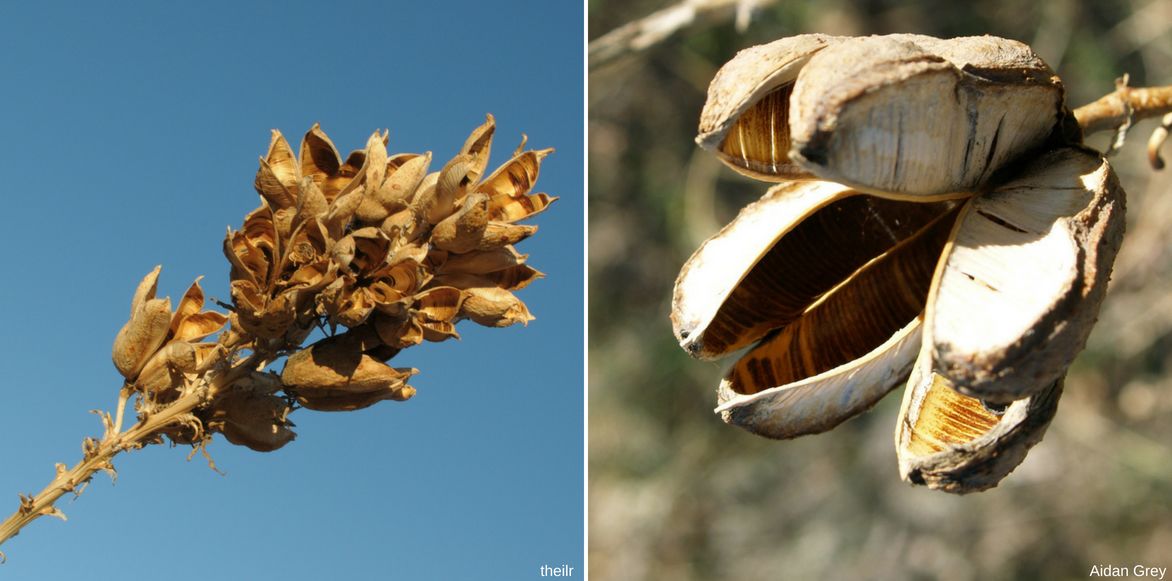
Withered inflorescences of a Yucca.
Young Yuccas can receive a generous mulch of leaf litter or gravel before the cold arrives to help them through the winter.
For potted Yuccas, water 2 to 3 times a week in summer. Move them indoors in autumn to protect them from frost in colder regions and reduce watering in winter, stopping fertiliser applications; water every eight to ten days. Always allow the soil to dry out well between waterings. Place the pot in a bright, unheated location: be careful, the sun should not hit the windows during the hottest hours. The indoor Yucca will appreciate a light misting of its leaves, especially in winter.
Every 3 to 4 years, in spring, repot your yucca into a slightly larger pot or, for large yuccas that are difficult to repot, perform a top dressing by adding a layer of garden soil and potting mix about 1/3 thick.
A light pruning of the leaves is possible each year from February to May to contain its growth. It is better to avoid severe pruning to prevent disrupting its beautiful shape.
A simple trimming of the leaves whose tips have dried can also suffice without harming the sculptural appearance of the plant.
Diseases and potential pests
The Yucca is a robust disease-resistant plant. Indoor-grown Yuccas can be more susceptible to invasions of red spiders and scale insects that may discolour the leaves; regular misting with non-calcareous water will often suffice to dislodge them.
When grown under good conditions, the Yucca is nearly indestructible. In open ground, watering should be moderate as it fears humidity at its roots more than anything else: the plant’s leaves can deform and rot in case of excess.
The leaf spot disease can mark the lower leaves of the Yucca with round brown spots. These may eventually dry out completely. This is a cryptogamic disease caused by a fungus – Phoma – that thrives in damp, poorly drained soils. Remove and burn the affected leaves. As a preventive measure, at the end of autumn and the beginning of spring, carry out a Bordeaux mixture spray.
→ Learn more about the diseases and pests of Yucca in our advice sheet.
Multiplication
As it ages, the Yucca produces small offsets, forming a small cluster of trunks after a few years. The propagation by cuttings or by division of these offsets is very simple, provided you wear good gloves to protect yourself from their fierce spikes.
By head cuttings
The recovery is very easy.
- In spring, using a saw, cut off leafy heads from the upper part of the trunk, about 30 cm long, or cut sections of approximately 15 cm long from a nice branching
- Plant the cut pieces directly in a pot filled with well-draining substrate or push them directly into the ground in the garden
- After a month or two, a rosette of leaves will appear
- Transplant your new Yucca plants into the ground
- Water them regularly
→ Learn more about propagating Yucca in Sophie’s advice sheet
By division of offsets
This is done on offsets that are at least two years old.
- Using a knife, take leafy offsets of 15 to 25 cm
- Plant in pots 10 to 12 cm in diameter filled with a mixture of turf and coarse sand
- Place the pots in light without direct sunlight
- Keep the substrate moist until roots form after 6 to 8 weeks
- Repot the young plants in spring
- Fertilise during growth with a liquid fertiliser
- You can plant them in the ground when they are strong enough
Associating Yucca in the garden
The Yucca is a valuable architectural plant for creating unparalleled focal points. With its sword-shaped erect leaves, spectacular summer flowering, and warrior-like appearance, the Yucca is always an important focal point in a garden or in a pot on a balcony or terrace. This is why it is often planted in isolation, on a short grass meadow or in a corner of the garden, or to border sumptuous pathways.
Its sharp foliage and beautiful architectural silhouette all year round always bring grandeur, exoticism, and verticality to a decor.
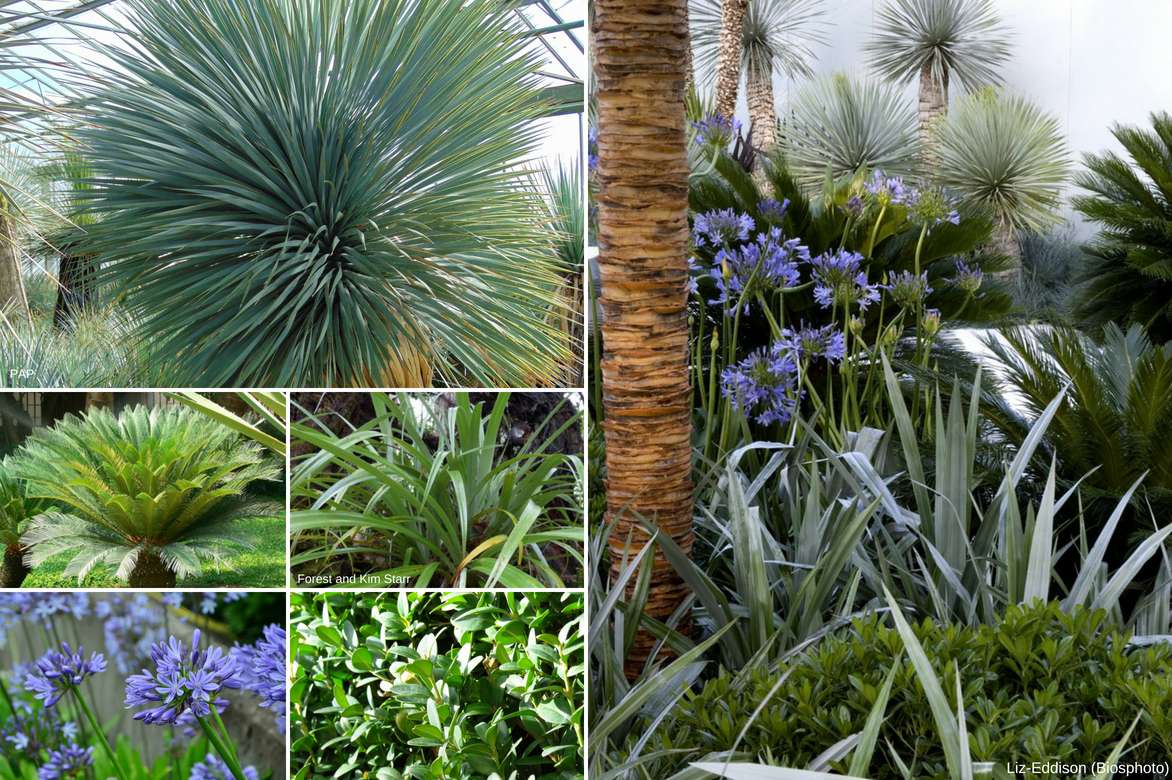
An example of an exotic association in a mild climate: Yucca rostrata, Astelia chathamica ‘Silver Shadow’, Cycas revoluta, Agapanthus, Buxus sempervirens.
A centrepiece of exotic-inspired gardens, contemporary or Mediterranean, the Yucca is the ideal plant in a large rockery, to crown a dry slope, or to add relief to a bed of low Mediterranean perennials and small bushes.
A bit difficult to associate due to its strong personality, the Yucca will gladly be surrounded by “supporting” plants that are just as undemanding as it is.
For a beautiful scene with exotic looks, surround them with Watsonias, Kniphofias, Cannas, large dahlias, and Crocosmias. It will make a sensation surrounded by lower plants such as evergreen shrubs emblematic of Mediterranean gardens like lavenders, a small hedge of myrtles or rosemary, and Pittosporum.
On a dry slope, scorched by the sun, associate it with prickly pear, large giant fennel, candle cacti, Elegia elephantina, opuntias, and Canary viper’s bugloss, all equally undemanding.
In a contemporary garden with clean, mineral lines like a scree garden or dry garden, it pairs well above a sea of white pebbles with bamboos, cordylines, and phormiums. It also pairs well with the structuring architecture of Chinese palms, miniature palms, or agaves.
In natural scenes, it will make a sensation mixed with large grasses like pennisetums or miscanthus that will soften the prickly personality of the Yucca.
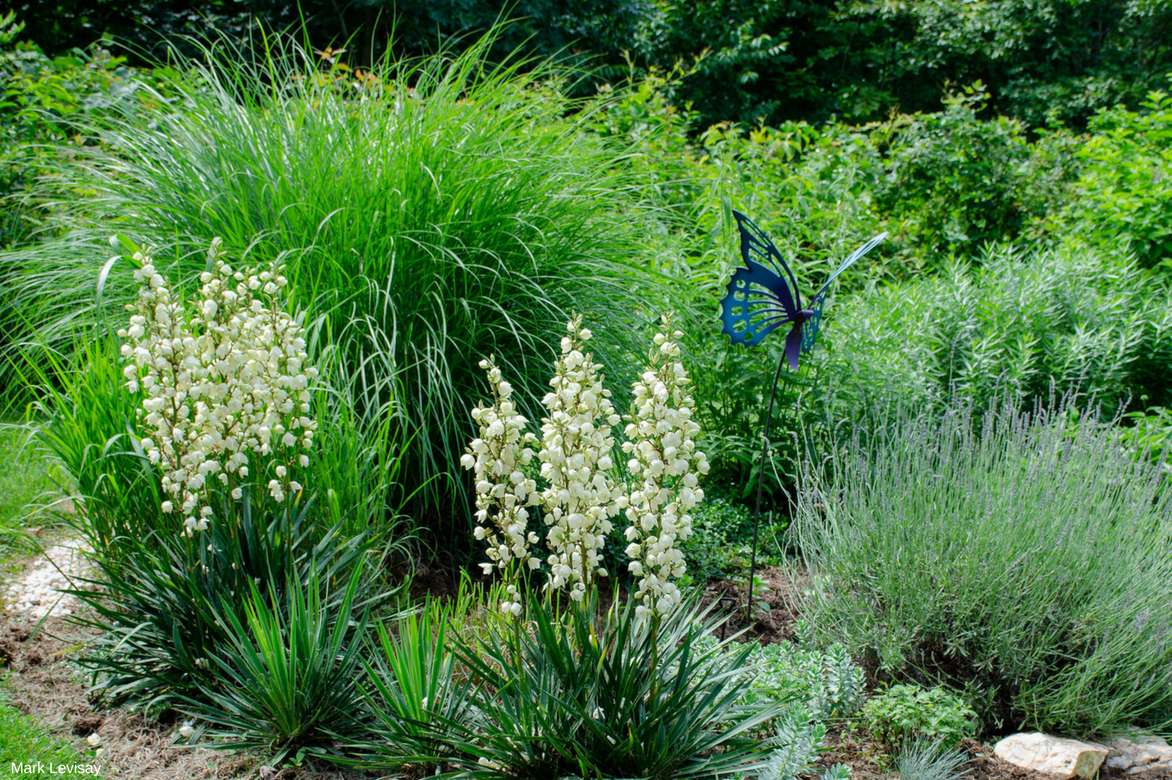
An example of an association: Yucca gloriosa, Miscanthus, and lavender.
In a pot, it will neighbour with Proteas to bring an exotic and fascinating touch to your terrace.
→ Discover more association ideas with Yucca in our advice sheet!
Useful resources
- Exotic, graphic, how to compose an exotic garden?
- Yuccas in a contemporary garden? We say yes!
- Which exotic plants to accompany your Yuccas?
- What are the most graphic plants to create a minimalist and clean atmosphere
- Advice sheet: Choosing a yucca
- Advice sheet: The most beautiful yuccas
- Advice sheet: succeed in growing Yucca elephantipes
- Advice sheet: plants resistant to sea spray
- Invite agaves, yuccas, and cacti into your garden!
- Tutorial: How to multiply Hesperaloe or Red Yucca?
Frequently asked questions
-
Why isn't my yucca flowering?
If your Yucca has never flowered, it is likely too young or has been in your garden for less than four years. Yucca takes time to establish, and flowering only occurs on specimens that are several years old, after 5 to 8 years of cultivation, depending on sunlight and climate. The Yucca needs plenty of sun and warmth the previous summer to flower well. You can optionally top it to encourage branching, which will encourage it to flower!
-
Is my yucca's leaves yellowing a serious issue?
Yucca really dislikes having its feet in water! An excess of water is undoubtedly the cause of the yellowing of the leaves. Its worst enemy is stagnant humidity, so banish water-retaining pots. Repot in dry, fresh compost, ensuring to spread a good layer of gravel at the bottom of the pot beforehand, and allow it to regain its strength before watering; Yucca is very resilient, it should bounce back.
-
I think my yucca has frozen, what should I do?
At first, nothing. It's better to wait for the return of the beautiful season, at the end of May, when you can truly assess what is dead or what is capable of regrowing. Most Yucca can withstand temperatures down to -25°C, even if they lose their leaves. If it does regrow, remember to protect it next year with a winter cover and a good mulch.
-
My Yucca is rotting, how can I save it?
If your yucca has lost almost all its leaves, even the green ones, and the trunk has become soft, this is not a good sign. The soft part of a yucca trunk is a sign of rot. This means you are likely overwatering. Allow the root ball to dry out well between waterings, especially in winter. Remove all the soft parts and keep only what is healthy to prevent total rot.
- Subscribe!
- Contents
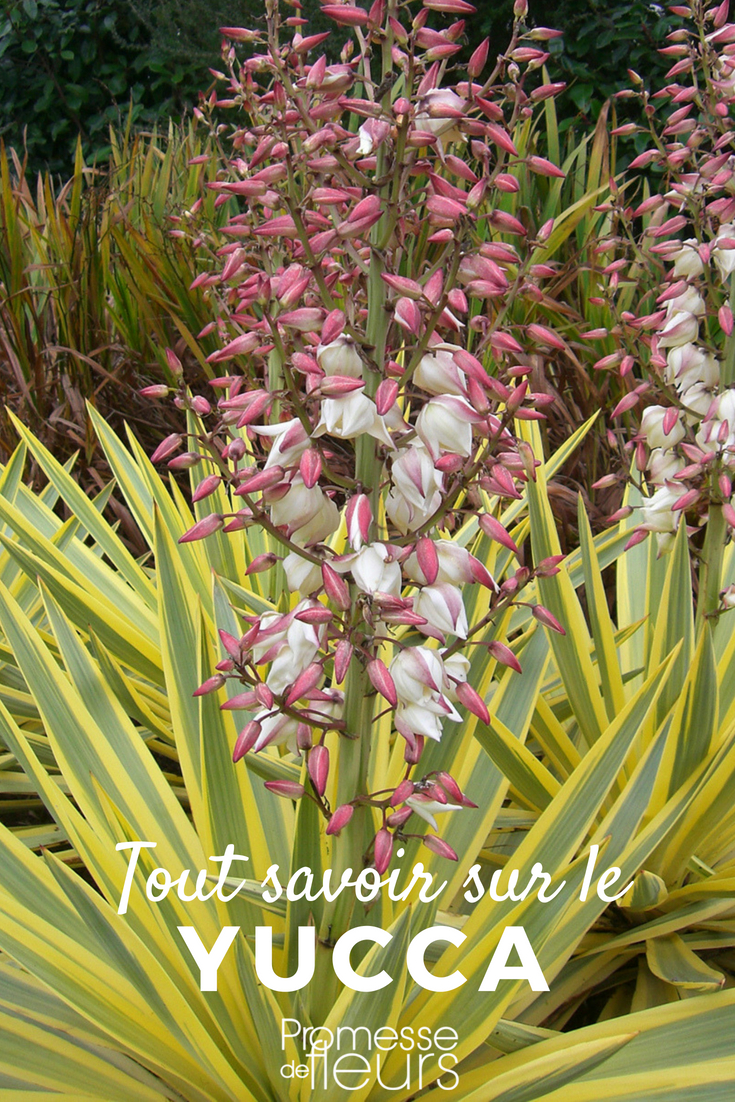































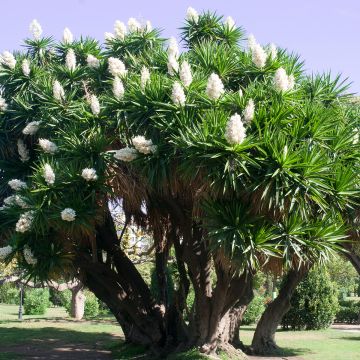
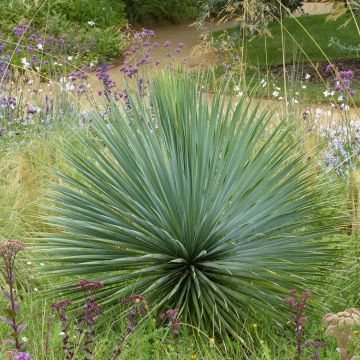
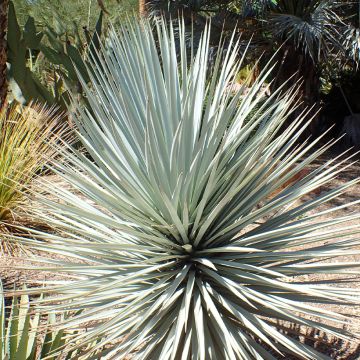





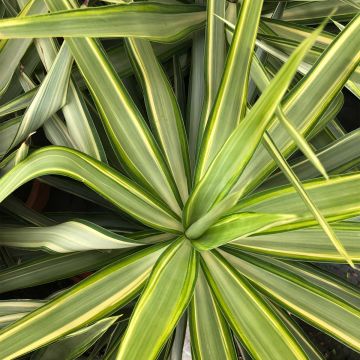

Comments